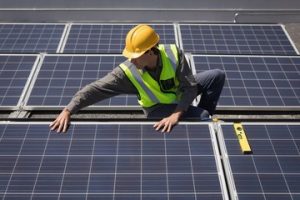A clean window can enhance your home’s appearance and increase its curb appeal. It also protects windows from damage caused by environmental pollutants, reducing the risk of rot and deterioration in frames and seals.

To achieve spotless results, professional window cleaners utilize a variety of tools and techniques. In this article, we’ll discuss some of the equipment and cleaning solutions used by a trusted exterior window cleaning service. Read on Exterior Window Cleaning Service for more details.
As a professional cleaning service, we understand that clean windows are essential for any facility. They are a symbol of a well-maintained building and uplift the image of a space. We offer high-quality interior and exterior window cleaning services throughout Westchester County and New York City. Our crews are equipped with ladders and extension poles, as well as power washing equipment to help make sure your windows sparkle and shine.
Dirty windows are not only hard to look out of, but they can also cause permanent damage. Over time, dirt etching and hard water stains can distort glass. As a residential window cleaning company, we use the proper tools and specially-formulated cleaning solutions to avoid streaks and smudges.
Our crews know New York like the back of their hands. From narrow service alleys in Queens to crowded sidewalks in Manhattan, they are trained to navigate the city’s complex building layouts and strict safety regulations. We use rope access and lift operation to tackle jobs in the harder-to-reach places, ensuring each job is completed safely and efficiently.
Squeegees and Scrubbers
Squeegees help achieve a streak-free finish on windows, and scrubbers are used to apply cleaning solutions and agitate dirt on the glass surface. Professional window cleaners carry a variety of squeegees and scrubbers in different sizes to accommodate various window dimensions. They also use specialized cleaning solutions that cut through grime without leaving residue behind.
In addition to squeegees and scrubbers, exterior windows are often cleaned using a water-fed pole system. The long pole is equipped with a brush that sprays purified water onto the window, which removes dirt and other contaminants without leaving streaks or smudges. This method is especially effective for hard-to-reach windows.
Exterior window cleaning is an important part of overall home maintenance, as it protects the integrity of the glass and frames. Environmental pollutants, hard water stains, and debris can cause the surface of the window to develop permanent marks and scratches, which can lead to leaks, energy loss, and structural damage. Consistent window cleaning by a professional can prevent these problems and keep the glass and frame looking great.
Window cleaning can be dangerous, especially for homeowners that aren’t comfortable working on ladders for extended periods of time. A professional window cleaner is experienced in working at high elevations and knows how to avoid safety hazards. They will also follow ladder safety guidelines, including maintaining three points of contact and not overreaching.
Squeegees are the primary tool used for cleaning indoor windows, but they’re also an excellent choice for outdoor windows. They’re designed to create a seal against the window that pulls water away completely, resulting in a streak-free shine. They’re also available in a range of widths to accommodate different window dimensions.
When choosing a squeegee, look for one that’s lightweight so your arm doesn’t get tired quickly. It should also be made of durable materials that can withstand the elements and resist scratching. Some squeegees come with scrubbers attached, which makes the cleaning process even more efficient. The Unger Professional Squeegee Tool, for example, features a rubber squeegee and a scrubber sleeve that can be mounted on a telescopic pole for easy use.
Cleaning Solutions
Clean windows make a powerful statement about your business, whether it is located in the heart of a busy city or set in the tranquil countryside. Regardless of the type of environment, frequent cleaning helps maintain glass quality and appearance while extending the lifespan of frames. The longer window frames last, the lower your maintenance costs will be over time. A professional window cleaning service has the tools and solutions necessary to achieve sparklingly clean windows, even for those on second-story windows that require ladders and extension poles.
Unlike DIY cleaners, a professional window cleaning service uses specialized cleaning solutions that cut through grime without leaving residue behind. They also use squeegees and water-fed telescopic poles to safely reach high windows, including those in nooks and crannies that are difficult to access. They also know the city like the backs of their hands, adapting to its unique building layouts and safety regulations.
Exterior windows accumulate dirt, grime, and environmental pollutants more frequently than interior windows. This makes it important to keep up with regular cleanings to prevent long-term damage and wear. In addition to reducing glare and improving visibility, frequent cleanings help protect frames from deterioration and ensure seals remain intact.
The frequency of exterior window cleaning depends on factors such as environmental pollution levels, weather conditions, and the size and type of building. However, most professionals recommend a quarterly cleaning schedule for most residential buildings.
Choosing a professional window cleaning service is one of the best decisions that you can make for your home or business. Trying to do it yourself is risky, and can lead to smudges, streaks, and hard water stains. It’s also a time-consuming project that often falls to the bottom of your to-do list. Hiring a professional saves you the hassle, gives you better results, and keeps you safe from injury. Plus, a professional knows the ins and outs of ladder and window cleaning and can detect issues like damaged or broken seals and rotting frames during the cleaning process. Ultimately, it’s well worth the investment. To learn more about the services and benefits offered by professional window cleaning companies, contact a local company today.







